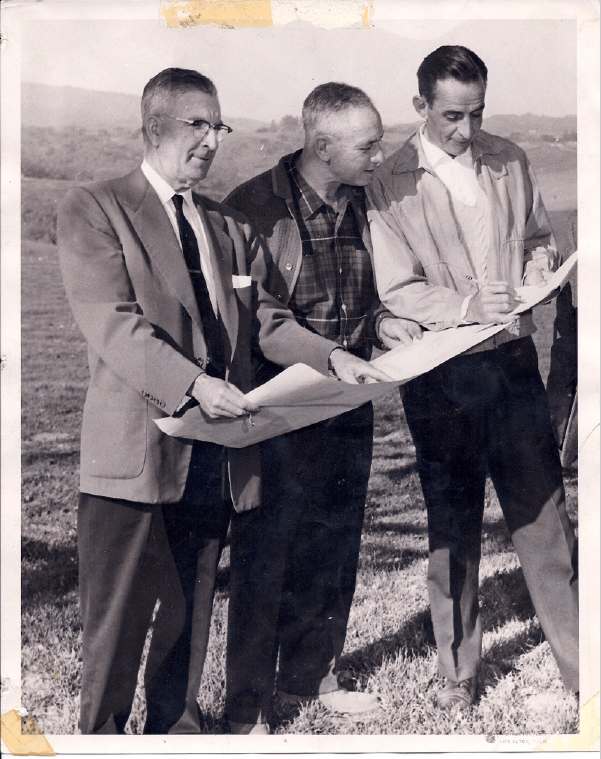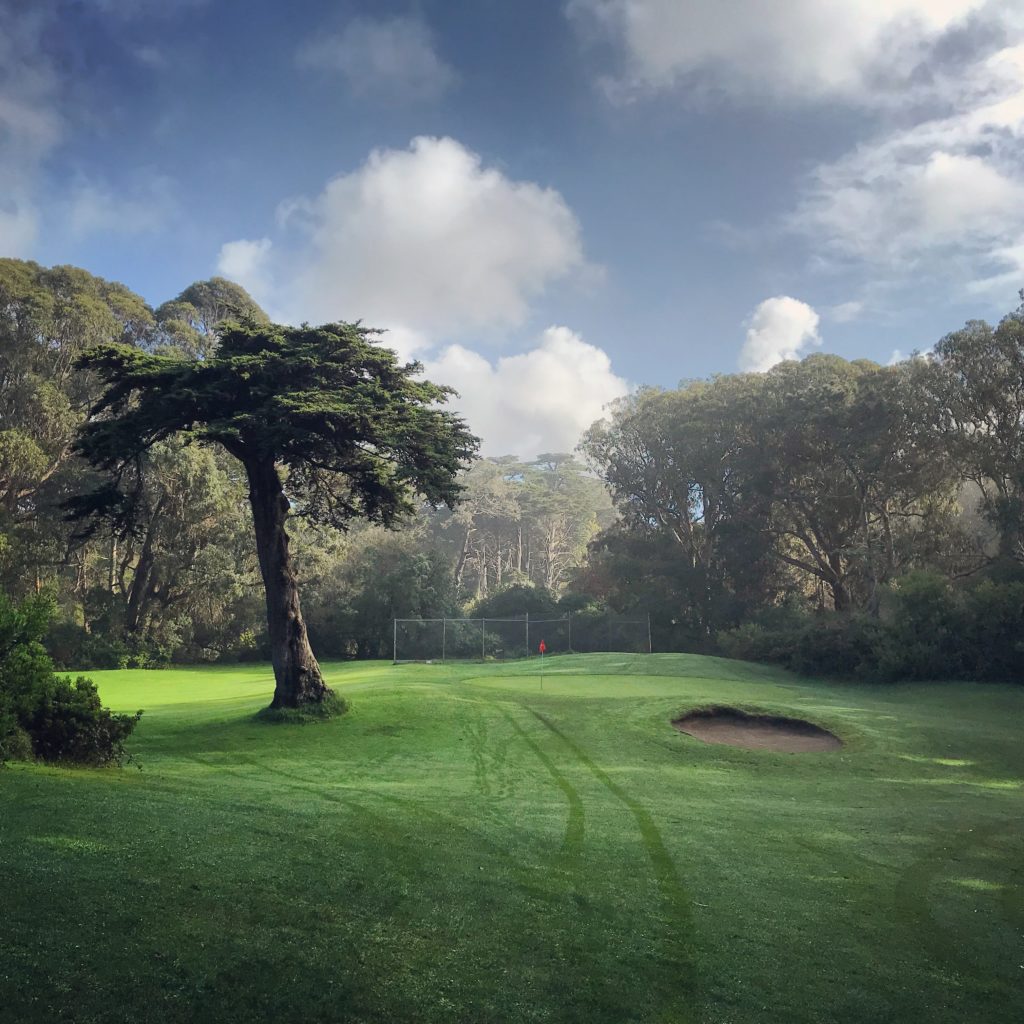
John “Jack” Fleming was born in 1896 in County Galway, Ireland, which may make one assume he was a natural for golf design. The game was still in its infancy in Ireland though, and Galway to this day is one of the lesser golf-populated regions of all the British Isles.
Fleming himself admitted to initially having little desire to work in the golf business:
“I certainly never thought I’d become a golf architect. I left my home in Galway at 18 and went to Dublin. I took a night school course in landscaping and civil engineering hoping someday to manage the grounds of a wealthy Englishman. Golf never entered my head.”
A few years later he was working as a timekeeper and paymaster on a city project in Manchester, England. That project happened to include a golf course — a golf course that happened to be designed by a man named Dr. Alister MacKenzie. He met MacKenzie at a pub over a game of darts, and thus began a partnership that spanned the rest of the Good Doctor’s life.
Fleming began as a clerical worker in the MacKenzie firm but ultimately wore many hats, working as a junior design associate and construction foreman in addition to his roles as timekeeper and paymaster. He and MacKenzie completed several projects around Europe (mostly in the British Isles) until 1926, when they were called off to a faraway land — California.
The Meadow Club in Fairfax was MacKenzie’s first assignment in the United States, and he brought over Fleming to supervise the job. Fleming secured a two-year visa to the U.S., but additional MacKenzie projects kept him around long enough to earn full citizenship.

And who would blame him? Some of those projects would become world renowned — Pasatiempo, the Valley Club of Montecito, Sharp Park and, of course, Cypress Point.
Fleming shared this exciting and critical period of golf course development with other important figures and luminaries associated with MacKenzie. They would include Bobby Jones, Marion Hollins, Robert Hunter, H. Chandler Egan and Paddy Coll, the Irish artisan responsible for finishing Cypress Point’s bunkers. Coll continued to work with Fleming into the 1960s.
In 1932, the effects of the Depression were starting to be felt in California. Coincidentally, John McLaren, the “Father of Golden Gate Park” and head of the San Francisco City Parks Department, offered Fleming a head greenskeeping job for the San Francisco City courses, which included the newly finished Sharp Park in Pacifica. At MacKenzie’s urging, Fleming accepted the position and held it for the next 31 years, always striving simultaneously for better turfgrass and lower maintenance costs.
His role with the Parks Department allowed him some opportunities to practice design work as well, starting with a 1934 remodel of Harding Park that included new greens, tees, bunkers and the cypress trees that famously fill the property today.
In 1941, the construction of a new sea wall at Sharp Park affected a number of the beachside holes. Fleming added four new holes east of Highway 1 and tweaked a few other holes that had been altered.

It wouldn’t be until the 1950s, though, that his design career would fully take off. Between 1950 and 1967, Fleming designed and built 36 courses, then did two more after that. A vast majority of these projects were located in Northern California.
About half of his projects also happened to be nine-hole courses, and a few were of the short or “executive” variety. Fleming was very much a champion of the shorter course, which was a solution to land scarcity in Northern California but also allowed a more recreational option and a place for beginners to develop their game. Today, they are gaining traction as an option to accommodate time for golf within increasingly demanding schedules.
Many of these courses were built on the infields of racetracks, but few have survived, unfortunately. But two prominent examples in San Francisco do remain — the 2,100-yard Jack Fleming 9 at Harding Park and the par-3 course in Golden Gate Park.
Some of Fleming’s other best works include Sierra View, Sharon Heights, Boulder Creek and Adams Springs. Fleming said of Sierra View, “I left everything as it was and added a little grass. The hills were just right, and I didn’t have to cut down a single tree.”

But none of those layouts may beat out San Francisco’s Gleneagles at McLaren Park for overall playing interest. While a number of bunkers have been added and shifted, the two main staples of any design — the routing and the greens — remain largely intact from Fleming’s original design. The medium-small putting surfaces are quick and tilt in all directions, with contours both subtle and bold.
It is this variety in the shapes and strategies of the greens that set the course apart from its 1960s contemporaries, which often repeated similar greens concepts (plain back-to-front tilt) for all 18 holes. Rather, it feels more like a course built in the 1920s — The “Golden Age of Golf Course Design.” With the architect’s background, it is not hard to see why that is.
Jack Fleming by all accounts was a good man — passionate about his work, full of energy and loving toward his family. He was a consummate professional — he always wore a dress shirt and tie no matter how messy the construction site — but also had a lot of fun within the day-to-day work.
His projects, according to his son John, were “like guys going off on a fishing trip.” His legacy is fascinating — not just for the influence from the numerous courses he built, but also for the way he ties us back to golf design’s most important era: The Golden Age.
“Dr. MacKenzie and I both believed that golf courses should be designed with two things in mind,” he once said. “First, that every shot should be laid out so that the golfer must use his head and think. Second, the architect should make use of the terrain upon which the course is built.”
Notable Jack Fleming Original Designs
- Golden Gate Park GC (1950) – San Francisco, CA
- Swensen Park Municipal GC (1952) – Stockton, CA
- Lake Chabot GC (1955) – Oakland, CA
- Almaden Golf & Country Club (1955) – San Jose, CA
- Sierra View Country Club (1956) – Roseville, CA
- Salinas Country Club (1957) – Salinas, CA
- Santa Rosa Golf & Country Club (1958) – Santa Rosa, CA
- Napa Municipal GC (1958) – Napa, CA
- Turlock Golf & Country Club (1959) – Turlock, CA
- Gleneagles International GC (1962) – San Francisco, CA
- Adams Springs GC (1962) – Cobb, CA
- Fleming Course at Harding Park (1962) – San Francisco, CA
- Sharon Heights Golf & Country Club (1962) – Menlo Park, CA
- Mather GC (1963) – Mather, CA
- Meadowood Resort (1965) – St. Helena, CA
- Mace Meadows GC (1966) – Pioneer, CA

Special thanks for assistance with this article go to Maureen Woods, daughter of Jack Fleming; John Walsh, grandson of Jack Fleming; and Sean Tully, superintendent of the Meadow Club and golf historian.

I did some extensive research and think I’ve come up with a reasonably comprehensive portfolio of his work after departing from MacKenzie’s firm.
1. 1934 – Harding Park remodel – much of the current layout remains from what can be seen on Google Earth 1938
2. 1941 – Sharp Park remodel – current layout is Fleming’s reworking of the original layout due to storm damage, maintenance and environmental issues with the course. Holes 4-7 are pure Fleming.
3. 1947 – Pittsburg Golf & Country Club (Back 9 of Delta View) – awesome 9 capturing Fleming’s style and use of land. Flows very well and sets up nicely. CLOSED 2018
4. 1949 – Blue Rock Springs – much of the old layout was altered when the East course was built in the early 90’s. Holes 4 (used to be a par-3), 5, 6, 8, 9-10, 16-18 (maybe parts of 13-15 used to be a hole) on the West and on the East 18 remains with 1-4 being altered.
5. 1950 – Golden Gate Park
6. 1952 – Swenson Park (18-Hole course)
7. 1953 – Sierra View CC
8. 1955 – Lake Chabot (Vallejo) – 18-hole executive course with a 275-yard par 3. Property was sold to Marine world and demolished in 1985.
9. 1956 – Almaden CC
10. 1956 – Mount Saint Helena – underrated 9-hole par 34 on the Napa County Fairgrounds. CLOSED 2019 due to wildfire damage. Possibly will re-open.
11. 1957 – Roseville Rolling Greens – 9-hole par 27 in Roseville. CLOSED 2017
12. 1957 – Salinas Golf & Country Club (The Club at Crazy Horse Ranch)
13. 1957 – Salinas Fairways – remodeled in 1998, but the original layout appears to remain intact
14. 1958 – Napa Municipal Golf Course – Interesting course. Some really awesome holes mixed with Fleming doing the best he could with the conditions (Napa river flooding and water quality killing grass on fairways and tee boxes). The eastside of the course has a good layout and makes great use of the land where much of the westside suffers from conditioning that necessitates its use of turtleback greens.
15. 1958 – Santa Rosa Golf & Country Club
16. 1959 – Turlock Country Club remodel
17. 1959 – Mather Golf Course – originally a military course?
18. 1961 – Harding Park Fleming 9 – built a pretty solid 9-hole par-30 on the eastside of the property. He would have had to have re-routed the 18-hole course during this time to allow for the 9-hole to fit.
19. 1961 – Boulder Creek Golf & Country Club – 9 holes built in ’61 and 9 more in ’66. No data was found and have to assume Fleming returned for the now back 9.
20. Adams Springs – cool, little 9-hole par 34
21. 1962 – McLaren Park (now Gleneagles) – legendary 9-hole in the southside of San Francisco
22. 1962 – Sharon Heights CC
23. 1963 – Cypress (Colma) – This used to be an awesome 18-hole built into the hillside. One would have to imagine playing very similar to Gleneagles. Unfortunately the original owners sold half the course to the cemeteries turning into a 9-hole par 37 and further downsizing until its final closure in 2012. Now all that remains is a driving range and practice facility. CLOSED 2012
24. 1963 – Dry Creek Ranch
25. 1965 – Meadowood Resort – CLOSED. The course was damaged during the Glass Wildfire. The resort is undergoing a remodel and the golf course’s survival is definitely in question. I couldn’t find (I also didn’t dig too much) if they’re going to salvage the course of just make alternate use of the land.
26. 1965 – Spring Creek Golf & Country Club
27. 1966 – Manteca Park – originally a 9-hole course with 9 more being added in the late 80’s. Fleming’s 9 would most likely be the current 9 holes on the east side of the property.
28. 1967 – Pruneridge – 9-hole par 30
29. 1972 – Mace Meadows – originally a 9-hole course. In the late 80’s they added 9 more holes using a small firm and Jack’s son John as a consultant.
Not a huge portfolio, but a pretty decent one. Definitely designed his courses on a budget and had excellent use of existing landforms as opposed to moving lots of earth to construct holes.